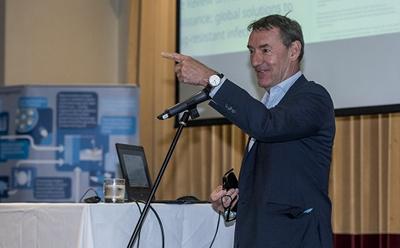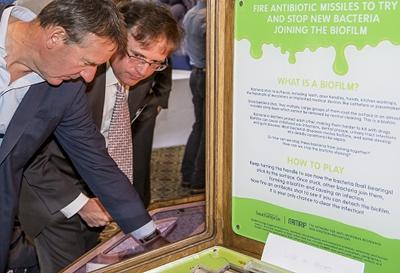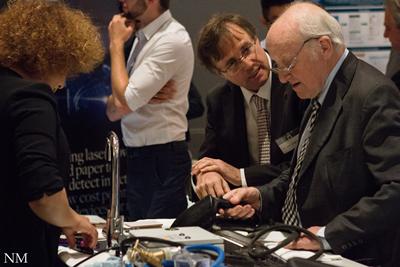Lord O'Neill of Gatley praises NAMRIP's outreach initiatives at the NAMRIP summer conference

The University of Southampton's Network for AntiMicrobial Resistance and Infection Prevention (NAMRIP), conference and exhibition, on 5 June 2017, was a huge success.
A large audience heard illuminating guest lectures from Lord O'Neill, who opened, and Lord Selborne, who closed the proceedings.Lord O'Neill toured the exhibition before his lecture and spent time hearing from the twenty exhibiting researchers about their NAMRIP pump priming projects. He had a go on the NAMRIP exhibit 'The Most Dangerous Game in the World' and admired its hands-on way of conveying the practical messages about AMR and what individuals of all ages can do to contribute to the solution. He even took photographs and later said, in his speech, that he would be telling Dame Sally Davies about it at a high level AMR meeting. His speech offered excellent insight into global and government perspectives on AMR, and introduced details that underpinned the establishment of his 2014 AMR Review, to the assembled AMR experts, along with how discussions and commitments in national Governments, the G20 and the United Nations had combined to shape policy.

Over 100 delegates attended the conference including representatives from academia, hospitals, industry, policy making and the public.
Speakers reported on their NAMRIP pump priming projects, giving a range of papers on multidisciplinary topics related to AMR, some describing promising fundamental research and some talking about how products, translated from previous fundamental research, have been adapted too provide AMR and infection prevention solutions.

The exhibition was a highlight of the conference where around twenty teams brought spectacular displays for conference delegates to see, photos of which are available here. Demonstrations included using chewing gum to deliver precise doses of targeted antibiotics; the 'wacky tacky octopus' display to show how biofilms operate; and the Starstream method of safe cleaning that removes all bacteria with cold water. The centrepiece was 'The most dangerous game in the world', conceived of by Professor Leighton and built by the Winchester Science Centre, who will have it on public display for the next five years, where it will receive a footfall of one million visitors. It will tour regularly to science festivals and was due to begin with Cheltenham Science Festival once the conference was over.
After dinner speaker, Lord Selborne enjoyed the displays, which he was able to tour before giving his speech. He reminded delegates that the spectre of AMR has been with us since antibiotics were invented. Alexander Fleming warned of the inevitable resistance that microbes would develop. Lord Selborne has been chairing the Science and Technology Committee in the House of Lords and Dame Sally Davies, he said, had been the one who finally got AMR off the back burner and into the limelight as a problem that needed to be addressed now.
Professor Leighton, who chaired the conference proceedings, thanked Dr Craig Dolder and Nikhil Mistry for the excellent effort they put in to get the logistics of the exhibition organised, and thanked Yvonne Richardson and Frances Clarke for the dedication, care, time and insight they demonstrated in their organisation of the conference. He also thanked all the NAMRIP members for their invaluable help and for giving their time. Without their commitment the conference could not possibly have happened.
For a list of the talks given at conference browse the full conference programme here.
I have been to conferences where presentations such as these come from £1 million grants each - it is a tribute to the tremendous work and dedication of the members of NAMRIP that these talks all come from pump priming projects of no more than £20,000 each. These are new collaborations that would not have happened without NAMRIP and its EPSRC backing. Furthermore we have seen time and again from NAMRIP members a commitment to ensure that promising research results are not simply published in journals where they might be read by six people in the world, but are in addition properly handed over to those who might benefit a million people from them- industry, policy makers, charities
List of exhibits:
- Paul Hurley & Matthew Olden: ‘In our hands’ – film by Joseph Turp, poem by Michael Rosen
- Paul Hurley: Mapping Microbes – video tracking application
- Paul Hurley: Wash ‘n’ Watch – prototype for animated automatic handwashing machine, created with assistance from Wallgate Ltd.
- Rod Herve: Improved surveillance of luminal endoscopes to prevent hospital acquired infections during endoscopyment
- Janos Kanczler: Preventing bone infection in orthopaedic implants
- Jay Laver: Exploring the use of a probiotic chewing gum for preventing infectious disease
- Parwez Hossain & Alison Hill: The Fight for Sight - a rapid diagnosis device for detecting eye infection
- Tim Leighton: The most dangerous game in the world
- Paul Elkington, Magda Bielecka & Liku Tezera: Designing novel 3D structures to help study drug-resistant tuberculosis to better evaluate infection and treatments
- Claire Jackson: Using simple sugars (perhaps in a nasal aerosol spray) to protect again bacterial infection
- Maryam Malakoutikhah & Craig Dolder: Demonstrating StarStream
- David Voegeli: Wound cleaning using StartStream
- Myron Christodoulides: Combatting the emergence of antibiotic-resistant Neisseria gonorrhoeae
- Tom Secker: Ultrasonic Decontamination and anti-fouling surfaces
- Eilish McBurnie, Alister Boags & Graham Saunders: First glimpses of antibiotics permeating through the bacterial cell envelope
- Robert Eason & Ioannis Katis: Testing of Antimicrobial Resistance to antibiotics via laser-patterned paper-platforms
- Robert Hull: Bugs and Biofilms: The wax moth larvae animal model
- Tim Millar: Developing devices to to tackle infections in heart valves
- Kieran Hand: Microguide smartphone application and web viewer - guiding clinicians in selecting most appropriate antibiotic